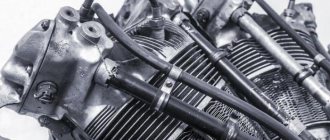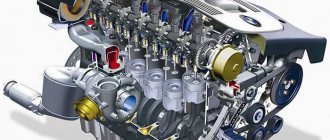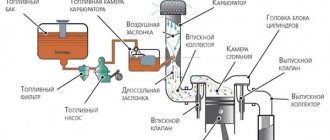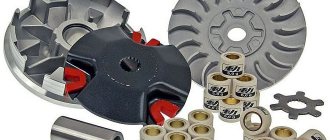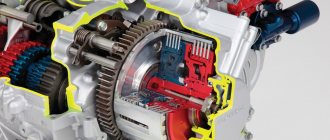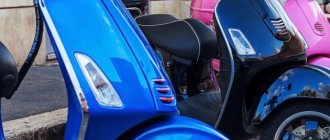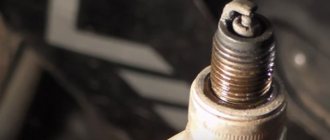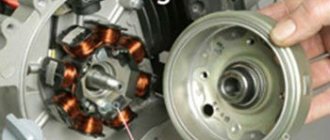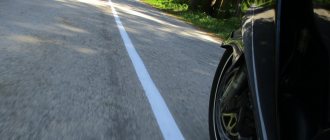What demands are placed on the fiery “racing” hearts of motorcycles? Maximum power and minimum weight immediately come to mind, but that's just the beginning. When thinking about power, you cannot limit yourself only to its maximum value. A huge role in the success of a particular engine is played by the way it delivers its power throughout the entire speed range. For simplicity, this is called character, but from a scientific point of view it is more correct to talk about power and torque curves. Why are these curves so important?
Aprilia's three-cylinder engine failed to propel the manufacturer to a MotoGP world title
It's all about gas dosing. Turning the throttle to a certain angle corresponds to a certain increase in power. In other words, for every degree there is a certain number of hairy horse butts (l.z., no, sorry - l.s.). And the more powerful the engine, the more hp. per degree of rotation of the throttle, and, therefore, it is more difficult to dose power. But that's not so bad.
A dry clutch is installed on the Kawasaki ZX-RR engine
If the power curve is non-linear (and for most engines it is), then it turns out that when the speed increases by the same amount (for example, by 3000 rpm), the increase in power in one speed range (say, from 3000 up to 5000, our conditional engine “gains” 15 hp) will differ significantly from the increase in another range (for example, from 5000 to 8000 it will gain 25 hp). And from this it follows that the number of hp. per degree of rotation of the throttle from 3000 to 5000 and from 5000 to 8000 will also be different (from 5000 to 8000 - more, in other words, in this speed range the engine will “pick up”). As a result, accurately dose the “gas” in the range of 5000-8000 rpm. it will be harder. On the one hand, it adds emotions and impressions. But the riders have more than enough of both. Therefore, on the track, a power curve shape that is as close to linear as possible is of great value.
Supersport 600 engine
A “flat” curve indicates that the nature of the engine is predictable (that is, the pilot knows in advance how the engine will react to a particular turn of the throttle), and it does not have pronounced “pick-ups” and “sags”, in which it is difficult dose power. The requirement for linear engine performance is so important that sometimes even peak power is sacrificed to achieve it.
The next requirement is related to reliability. Due to the enormous loads that internal engine components experience, it is often difficult to ensure the required service life of racing engines. In other words, the engine must be able to withstand at least one round of racing.
The RC211V motor is one of the most tightly packed
Engine size also plays a significant role in success. If designers manage to make the motor more compact, then this allows them to “play” to a large extent with the position of the center of gravity, which directly affects numerous nuances of the motorcycle’s behavior. The smaller engine size also makes it easier to centralize mass, which affects agility. The last major requirement for racing engines is similar to one of the conditions for braking systems. Since the engine has many rotating (and sometimes very quickly!) parts, they, like wheels with brake discs, are gyroscopes and flywheels. The gyroscopic effect of the rotating engine parts affects the motorcycle's ability to quickly change trajectory, and the flywheel's ability to accelerate quickly. As with brakes, it is advisable to minimize both.
Having been horrified by the complexity of the task at hand, let's look at how all these technical requirements are met (if they are met!) in motorcycles of various classes.
Two-stroke engines in MotoGP are now part of history
Let’s start tinkering with engines with the buzzing two-stroke “stinkers” of the “GP-125” and “GP-250” classes. The small displacement of these one- and two-cylinder engines directly limits power and narrows the rpm range over which it is produced. Moreover, the power turns out to be so small (compared to the MotoGP and SBK classes) that there is no time for a linear characteristic. In this class, even half a horse is expensive. Therefore, they squeeze out the power to the last drop. To reduce friction losses, the number of piston rings is reduced to one. The width of the main bearing raceways is kept as small as possible. Another drop of power comes from the use of a high-flow racing radiator. Its use allows the pump to more easily pump water in the cooling system. The result is another “useful” “pony”. By the way, engine temperature also directly affects power. The general rule is: higher temperature - lower power, and vice versa. Therefore, racing engines are especially critical to cooling.
The compression ratio is raised to incredible values for a two-stroke engine, and the carburetor, exhaust and ignition system are adjusted to operate at maximum speed. All this leads to monstrous non-linearity of the torque and power curves. Fortunately there is relatively little of it. Because of this and the ability of the GP-125 and 250 motorcycles to corner at enormous speeds, there are no great difficulties with dosing power - many corners simply do not require you to let off the gas. The reliability of two-stroke engines GP-125 and 250 is low due to the high degree of boost and lubrication features. Wealthy teams change pistons every race day, while less wealthy teams change pistons before each race.
Ducati engines dominate the Superbike championship
The next level of the “motor” hierarchy is the Superbike class. It is especially interesting to us because these engines (except for the Foggy Petronas FP-1) are derived from the engines of ordinary road sportbikes. The WSB championship uses three engine configurations: V-twins, in-line triples and fours. But these “power generators” have gone monstrously far from their road counterparts.
Suzuki team mechanics work on the GSX-R1000 engine
As an example, we will trepan the engine of a Suzuki GSX-R1000 2005 model year. As the British say - “The Devil is in the details” (loosely translated - “The dog is buried in small nuances”). The engine of the Jixer consists entirely of them. Forged mini-skirted pistons, titanium valves, racing camshafts are just the beginning. Upon closer inspection, the shape of the piston rings is striking. Their cross-section is not rectangular, but trapezoidal. This allows you to reduce friction losses. The crankshaft of the motorcycle comes perfectly balanced from the factory. The clutch is initially “slippery”. Moreover, its design turned out to be so successful that some teams change only the disks and springs, and leave the “basket” itself as standard. But the biggest surprise is in the crankcase design. There are holes in the crankshaft supports dividing the crankcase space. They are designed to make the way easier for crankcase gases, which are forced out by the descending pistons into adjacent compartments where the pistons rise. This technical solution alone gives an increase of about two hp.
Honda RC211V crankcase with oil level window
In the royal class of MotoGP, engine design represents the apotheosis of engineering and breaks down all technical barriers. Due to the colossal power, the requirement for linear engine performance in MotoGP is the most stringent. It is no longer possible to achieve a flat power curve with engine design alone, and electronics come into play (see the material “Electronics” in one of the upcoming issues). But even smart electronic engine management systems are not able to fully cope with herds of 250 hp. The MotoGP class is the territory of the “Big Bang”* (footnote: see “Moto” No. 1 2006). Only with its help were racing teams able to significantly ease the task of pilots who were tired of dealing with endless slippage. The clutch unit deserves special mention. The power in the MotoGP class is so high that the conventional multi-plate clutch in an oil bath becomes ineffective and often begins to slip.
Foggy Petronas clutch – dry
There are two ways out of this situation. You can either increase the number of discs (and thereby the mass of the clutch basket and the motorcycle as a whole), or make the clutch dry. Almost all MotoGP teams have chosen the second path. A dry clutch with fewer friction discs allows more power to be transmitted and does not contaminate the oil with friction products. But it also has a significant drawback - the difficulty of cooling. Unlike a conventional oil-bath clutch, a dry clutch is cooled only by air flow. Because of this feature, it is very easy to overheat, especially at the start. This is why a dry clutch can only survive two race starts before requiring repair.
Dry clutch of MotoGP motorcycle Honda RC211V
Another task that lies on the shoulders of the clutch is to prevent the rear wheel from locking when shifting several gears down at once. The slipper clutch partially copes with this negative effect, but often you have to resort to additional electronic help. But more on that later.
When talking about the engines of MotoGP cars, one cannot fail to mention the design of the gas distribution mechanism. Due to the huge speeds, the load on the camshafts, valves and springs of MotoGP engines is truly monstrous. To somehow reduce it, you need to use softer springs. But this increases the risk of valve sticking. Of course, you can make them from a light titanium alloy, but this still did not completely solve the problem. The springs remain quite stiff, and high speeds quickly lead to their destruction (there are cases when mechanics had to change valve springs every day!). The way out of this situation has long been known and is used in F1. Pneumatic valves use compressed air instead of springs. But unlike F1, this technology has not yet found acceptance in motorcycle racing. It was tested by several teams, including the departed Aprilia, but no one achieved success. However, this year Suzuki has resumed testing its pneumatic technology. And we just have to see what this leads to.
The engine of the Yamaha YZF-R1 superbike looks almost no different from the stock one
The last thing we want to mention in our study of MotoGP engines is the influence of the gyroscopic effect on the behavior of the motorcycle. As already mentioned, the rapidly rotating parts of the motorcycle are gyroscopes that prevent any changes in direction of movement. This is one of the main reasons that forces designers to reduce the weight of the wheels and crankshaft (the main gyroscopes of a motorcycle). But gyroscopes have an interesting property. If they rotate in one direction, their gyroscopic effect is summed up, but if the direction of rotation is the opposite, then the effects are subtracted, partially compensating each other. This property was what their designers tried to use in racing engines. Back in the days of the GP-500, some teams were testing engines with two counter-rotating crankshafts. This indeed compensated for their gyroscopic effect, but also significantly increased power loss. In the end, the use of two crankshafts was abandoned. But the modern Yamaha M1 has gone further. The designers, instead of compensating for the gyroscopic effect of the crankshaft alone, decided to reduce the influence of all the motorcycle's gyroscopes. To do this, they forced the crankshaft to rotate in the direction opposite to the rotation of the wheels. As a result, the overall gyroscopic effect has decreased and the motorcycle has become much more agile.
Dry clutch from STM on a KR Proton motorcycle
Another class of racing motorcycles whose engines are of interest is Endurance. Here, as in the case of brakes, the requirements are radically different from other classes. Since racing is “endurance”, the engine should be just that. How to increase the life of the motor? It’s enough just not to force it! Endurance mechanics are often limited to classic tuning: a “zero” air filter, engine management system (“brains”) and a complete exhaust system. “Limited” engine boost also allows you to keep fuel consumption at an acceptable level, and this reduces the number of pit stops. But what plays an important role is the mechanical strength of the engine, because even falls should not disable the motorcycle. To increase the “survivability” of the engine in the event of a fall, the standard generator and clutch covers give way to reinforced ones that can survive more than one contact with asphalt. I’ll digress a little, because I can’t keep silent about this: on board the Endurance racing motorcycles there is a set of tools and even a flashlight - so that the pilot can carry out minor repairs even away from the paddocks.
Author Anton Barsukov, photo by the author.
Types of motorcycle engines
There are two-stroke and four-stroke engines, the operating principles of which are somewhat different.
Also, motorcycles have different numbers of cylinders.
In addition to the original carburetor engine, you can often find injection units. And if motorcyclists are accustomed to fixing the first type on their own, then it is already problematic to repair an injection engine with a direct injection system with your own hands. Diesel motorcycles and even those with an electric motor have been produced for a long time. The article will discuss the characteristics of a carburetor-type motorcycle engine.
In-line three-cylinder engine
This transversely mounted unit is a development of the in-line two-cylinder engine. Engineers tried to find compromises between vibration and the size of the four-cylinder internal combustion engine. This scheme was the main one in the 70s.
There are many examples of this. Basically, Japanese Suzuki and Kawasaki equipment was used with in-line three-cylinder engines. There are other motor design schemes. These are four-cylinder, six-cylinder in-line and V-shaped units.
Four stroke engine
Such engines have a duty cycle of four piston strokes and two crankshaft revolutions. The engine diagram clearly shows the structure of a piston internal combustion engine and its working process.
- On intake, the piston moves down from top dead center, drawing mixture through the open valve.
- During compression, the piston rising from bottom dead center compresses the mixture.
- During the working stroke, the mixture, ignited by an electric spark plug, burns, and the gases move the piston down.
- When exhausting, the piston, rising, pushes the exhaust gases through the open exhaust valve. When it reaches top dead center again, the exhaust valve closes and the whole process repeats.
The advantages of four strokes are:
- reliability;
- efficiency;
- less harmful exhaust;
- little noise;
- Oil and gasoline are not pre-mixed.
The design of this type can be depicted by the following engine diagram.
Sportbike
We say “sportbike” - we mean “power-to-power”, the motto of the designs is maximum power with minimum weight. The rest is on the side. Why worry about drag at the bottom if the sportbike engine “loves to live” in the mode when the needle is at the red line of the tachometer. This is a high-end technical thought of the motorcycle industry, they contain all the latest developments. The best maneuverability, acceleration dynamics and braking efficiency - all these are sportbikes - conveyor versions of the famous two-wheeled Grand Prix cars.
Two stroke engine
The engine capacity of this type of motorcycle is usually smaller, and the working cycle takes one revolution. In addition, it does not have intake or exhaust valves. This work is performed by the piston itself, which opens and closes the channels and windows on the cylindrical mirror. A crankcase is also used for gas exchange.
The advantages of this engine are:
- with the same cylinder volume, it has a power that is 1.5-1.8 times greater than a four-stroke;
- does not have a camshaft and valve system;
- production is cheaper.
V-shaped two-cylinder unit
This unit is one of the most ancient. But today this scheme is still alive and in use. This design with two cylinders, a common crankpin and a V-shape design has no problems with the oscillating couple effect. The best cylinder camber angle is considered to be 90 degrees. Vibrations from this unit during operation are negligible.
This is an almost perfect motorcycle engine, but the camber angle makes the dimensions larger, making it difficult to mount it in the frame. But it is possible to do this - this is confirmed by motorcycles from Ducati. This arrangement is unconventional, but it is still found on sports cars participating in world championships.
Cylinders and the work process in them
The working process of one and the other engine occurs in the cylinder.
The piston here moves along a cylindrical mirror or insert sleeve. If air cooling is used, then the cylindrical jackets have ribs, and with water cooling they have internal cavities.
The crankshaft, through the connecting rod, perceives the movement of the piston, transforming it into rotation, and then transmitting torque to the transmission. It also powers the gas distribution mechanism, pump, generator and balance shafts. The crankshaft has one or more elbows depending on the number of cylinders.
In a four-stroke engine, in order to better fill the cylinder with the mixture, the intake begins before the piston reaches top dead center, and ends after it passes bottom dead center.
Its cleaning begins even before reaching bottom dead center, and exhaust gases are pushed out as the piston moves to top dead center. The exhaust valve then closes to allow the gases to leave the cylinder.
The following types of gas distribution mechanism are used on this type of engine:
- OHV;
- OHC;
- DOHC.
The latter type has a minimal number of elements, so the crankshaft can rotate faster. Therefore, DOHC is becoming increasingly common.
Four-stroke engines have a more complex design compared to two-stroke engines, as they have a lubrication system and a gas distribution mechanism that two-stroke engines do not have. However, they have become widespread due to their cost-effectiveness and less harmful impact on the environment.
Motorcycle engines are most often one-, two-, and four-cylinder. But there are also units with three, six and ten cylinders. The cylinders are in-line - longitudinal or transverse, horizontally opposed, V-shaped and L-shaped. These motorcycles usually have an engine displacement of no more than one and a half thousand cubic meters. Engine power is from one hundred fifty to one hundred eighty horsepower.
Motorcycle engines
As you know, internal combustion engines (ICE) are of three types, namely two-stroke, four-stroke and rotary.
The latter are not very common, but some motorcycle manufacturers still use them (Triumf). General structure and operation of the engine
Motorcycles are equipped with internal combustion engines (ICE), in the cylinders of which the thermal energy of burning fuel is converted into mechanical work. The reciprocating motion of the piston, which receives gas pressure, is converted into rotation of the crankshaft through a crank mechanism, which consists of a cylinder, a piston with rings, a piston pin, a connecting rod and a crankshaft. The extreme positions of the piston moving in the cylinder are called dead centers - top dead center (TDC) and bottom dead center (BDC). The distance from TDC to BDC is called the piston stroke, and the space created is called the cylinder displacement (cm3). The total internal volume of the cylinder consists of the working volume and the volume of the combustion chamber. The ratio of the total volume to the volume of the combustion chamber is called the compression ratio; the higher it is, the more efficient the engine's operating process is. Modern engines have a compression ratio of 9–10 units (higher values are found in sports models).
Piston internal combustion engine
| 1 - cylinder head; 2 - cylinder; 3 - piston; 4 — connecting rod; | 5 - crankshaft; 6 - crankcase; 7 - spark plug |
For two- and four-stroke internal combustion engines, the workflow and design of parts are somewhat different.
Four-stroke engines
In four-stroke engines, the working cycle occurs in four piston strokes (stroke) and two revolutions of the crankshaft: intake - the piston descends from TDC and sucks in the combustible mixture through the open intake valve; compression - the piston rising from BDC compresses the working mixture with the valves closed; working stroke - the mixture burns, ignited by an electric spark, and the resulting gases, expanding, move the piston down (this stroke of the piston is called the working stroke, since during it useful work is done); exhaust - the upward moving piston pushes the exhaust gases through the open exhaust valve.
Working process of four stroke engine
| a - inlet; b - compression; c — expansion (working stroke); g - release; | 1 — inlet valve; 2 - spark plug; 3 - exhaust valve |
Two-stroke engines
In two-stroke engines, one power cycle occurs per revolution of the crankshaft. Another feature is the absence of valves (intake and exhaust) with a mechanical drive. Their role is played by the piston itself, opening and closing special windows and channels on the cylinder mirror, and on some engines a reed valve is installed at the inlet. The crankcase volume under the piston is also used for gas exchange.
Working process of two-stroke engine
| a - inlet into the crank chamber, compression in the cylinder; b - ignition (before TDC) and subsequent combustion in the cylinder; c — release of exhaust gases from the cylinder and purging with a combustible mixture from the crankcase; d - diagram of a reed valve; d — appearance of the petal valve; 1 - purge channel; 2 — exhaust channel; | 3 - spark plug; 4 — petal valve in the inlet channel; 5 — inlet channel; 6 — crank chamber; 7 — reed valve body; 8 - limiter; 9 - elastic plate |
When the piston moves upward from BDC, the working mixture is injected into the sub-piston space, and in the space above the piston, the exhaust gases remaining from the previous cycle are first displaced, and later, when the windows are closed by the edge of the piston, compression occurs. At TDC, the mixture in the combustion chamber is ignited by an electric spark formed between the electrodes of the spark plug. The burning fuel-air mixture expands and pushes the piston down - a working stroke occurs. Having dropped approximately 2/3 of its stroke, the upper edge of the piston opens the windows in the cylinder. Exhaust gases under excess pressure exit through the exhaust window into the exhaust pipe. Through other windows, fresh charge enters the cylinder from the crankcase cavity, where the descending piston creates excess pressure. This flow of mixture is called purging, and windows and channels are called purging.
Modern two-stroke internal combustion engines have multi-channel (3–7 channels) return-loop purge. In addition, a check plate (petal) valve is installed at the inlet of the cylinder, which is controlled by the vacuum in the crankcase. During inlet into the crankcase (the piston moves from BDC to TDC), under the influence of vacuum in the sub-piston space, the valve plates open the passage of the combustible mixture from the carburetor. When the piston moves back (during purging), excess pressure in the crankcase closes the valve plates, preventing the mixture from being thrown back from the crankcase into the carburetor. The reed valve improves cylinder filling, increases engine power and efficiency, especially at low and medium crankshaft speeds. Many engines also have a special mechanism that changes the height of the exhaust port (and therefore the duration of exhaust) depending on the engine speed (the so-called “controlled exhaust”). Despite the measures taken to improve the gas exchange of two-stroke internal combustion engines, some of the mixture leaves with the exhaust gases, which reduces their efficiency compared to four-stroke engines.
The working process of both two- and four-stroke internal combustion engines occurs in the cylinder. The piston moves along the inner surface (mirror) of the cylinder or insert liner. In modern engines, instead of steel or cast iron liners, carbide nickel-silicon compositions (“Nikasil”) are used, sprayed directly onto the aluminum cylinder base. Depending on the type of cooling system adopted, the cylinder jackets have fins (air cooling) or internal cavities for the passage of coolant.
The piston perceives gas pressure during combustion of the working mixture. It consists of the upper and lower parts (head and skirt, respectively) and the piston pin mounting bosses. The shape of the bottom can be flat or convex; four-stroke engines often have recesses in the bottom for valves. In the piston skirt of two-stroke engines there are cutouts through which the combustible mixture passes, because in these engines the piston controls the gas distribution (intake, scavenging and exhaust).
Pistons of two-stroke (a) and four-stroke engines (b)
1 - piston head; 2 — selections for valves; 3 — compression rings; 4 — oil scraper ring; 5 — piston pin mounting bosses; 6 — piston skirt; 7 — cutout for the purge window; 8 — oil trap cavity (refrigerator); 9 — cutout for an additional purge window
The piston head has thickened walls that house 1–3 compression rings made of special cast iron or steel. These rings seal the gap between the piston and the cylinder mirror and remove heat into the cylinder walls. In four-stroke engines, in addition to compression rings, the piston has an oil scraper ring that removes excess oil from the cylinder bore.
The bosses serve as a support for the piston pin, they have grooves for the retaining ring and holes for oil mist lubrication. Often in the area of the bosses, on the outer surface of the piston, special recesses are made - refrigerators.
The skirt directs the movement of the piston. Due to the unequal thermal expansion of different parts of the piston, its outer surface is given a complex shape: barrel-shaped (conical) in height and oval in circumference. Pistons are made from high-quality aluminum alloys with a high silicon content, which can withstand high thermal and mechanical loads, and at the same time have a low expansion coefficient.
The piston pin pivotally connects the piston to the connecting rod. Typically, a floating pin fit is used in the piston bosses and the upper head of the connecting rod; it is secured from axial movements by spring retaining rings in the bosses.
The connecting rod transmits force from the piston to the crankshaft and consists of a rod (I-beam or elliptical section) and heads: upper and lower. Depending on the type of engine and the lubrication system used, the connecting rod heads are made with plain bearings (with bushings or liners) or rolling bearings (roller, needle). When a plain bearing (liner) is used in the lower head, the head itself is detachable. In the case of using a needle bearing, the head is made one-piece and the lower journal of the shaft is pressed into the cheeks.
Connecting rods
a - with a detachable lower head (“Dnepr”); b - with a one-piece lower head (“Ural”); 1 — connecting rod cover; 2 — connecting rod bolt; 3 — connecting rod; 4 — bearing separator of the lower head of the connecting rod and rollers; 5 — liners
The crankshaft receives force from the piston (via the connecting rod), converts it into rotational motion, and then transmits the torque to the transmission. In addition, other systems and mechanisms are driven from the crankshaft: gas distribution mechanism (GRM), oil pump (in four-stroke internal combustion engines), generator, cooling system pump, balance shafts. Depending on the number of engine cylinders and the design design, the crankshaft may have one or more elbows, each of which is formed by two cheeks and a connecting rod journal. Between the knees and along the edges of the shaft there are main journals supported on bearings.
Crankshafts are made composite or non-separable (one-piece). The type of bearings of its supports (main journals) depends on the lubrication system used. To improve the smooth operation of the engine (after all, only one stroke of the piston is working, and the rest - one for a two-stroke engine, and three for a four-stroke engine - require energy expenditure), the crankshafts have an external flywheel, massive cheeks and counterweights. In addition, many modern engines have special balance shafts driven by a gear train from the crankshaft.
Crankshaft of two-cylinder engine
b - solid (“Dnepr”); 1 — connecting rod with a one-piece lower head and a roller bearing; 2 - counterweight;
3D Motorcycle Engine
Four-stroke internal combustion engine. How it works?
Disassembling the Honda CBR929RR engine (part 1). The first part of a scary video of disassembling the engine of a Honda CBR929RR motorcycle. Someone has taken up residence in the engine and is growling, rattling, knocking. The bastards decided to find out who lives there and drive him out. To do this, we unscrewed all the attachments: covers, generator, drives, etc. The closer you get to “Alien”, the scarier it is...
The engine crankcase is made one-piece or with a split plane (longitudinal, transverse). In four-stroke engines, the crankcase (or sump) is usually a reservoir for oil draining from lubricated parts. Many engines share a common crankcase with clutch and gearbox. In two-stroke multi-cylinder engines, the crankcase volume of each cylinder must be separated from the others; this complicates the design of the crankcase when there are two or more cylinders.
Gas distribution in four-stroke internal combustion engines is controlled by a camshaft (or camshaft), which rotates twice as slow as the crankshaft. When rotating, the camshaft, with its protrusions (cams), interacts with pushers, which directly or through a transmission link (rocker arm, rocker) open the valves (intake and exhaust); their closure occurs under the action of valve springs. The periods of time when the intake and exhaust valves are open are called valve timing; they are coordinated with the piston strokes.
Valve timing diagram of a four-stroke engine
1 - opening of the intake valve; 2 - closing the intake valve; 3 - closing the exhaust valve; 4 — opening of the exhaust valve; angle “a” - valve overlap
To better fill the cylinder with the combustible mixture, the intake phase begins when the piston has not yet reached TDC. As the piston continues to move from TDC to BDC, it sucks in the combustible mixture through the open valve; they complete the intake after passing BDC, when part of the mixture enters the cylinder by inertia. Cleaning the cylinder from exhaust gases also begins at the end of the expansion stroke, when the piston has not yet reached BDC, but there is excess pressure in the cylinder. Then, as the piston moves from BDC to TDC, the piston pushes out the exhaust gases. The exhaust valve is closed after TDC to allow some of the exhaust gases to leave the cylinder by inertia. Thus, there is a period of time when both valves are open - this is called "valve overlap". Each four-stroke engine model has its own optimal valve timing, which is set at the factory by the profile of the camshaft cams. Some newer motorcycle engines have special devices that allow the valve timing to be changed depending on the crankshaft speed.
Modern four-stroke internal combustion engines use several types of timing belts: OHV, OHC, DOHC.
Schemes of gas distribution mechanisms
| a - OHV, b - OHC, c - DOHC; d — camshaft drive by chain; d — valve drive according to the DOHC scheme; e - five-valve head of Yamaha engines; 1 - camshaft; 2 - pusher; 3 - rod; 4 — lever (rocker arm); 5 — adjusting washer; 6 — crackers for fixing the plate; | 7 — plate (thrust bearing); 8 — outer spring; 9 — internal spring; 10 — support washer with oil scraper cap; 11 - valve; 12 — sprocket on the crankshaft; 13 — tensioner shoe; 14 — tensioner; 15 - drive chain; 16 — installation mark on the camshaft sprocket; 17 — chain damper |
In the OHV design, the valves located in the cylinder head are driven from the “bottom” camshaft via pushrods, rods and rocker arms; the design does not ensure smooth operation of the mechanism at high crankshaft speeds. Engines with an OHC timing belt have an “overhead” camshaft that acts on the valve lifters through levers (rockers); the shaft is driven by a chain or toothed belt. Modern multi-valve heads with 4-5 valves per cylinder use two camshafts, each of which directly acts on the valve lifters with its cams (DOHC design). This design has a minimum of parts and, because of this, the inertia of the valve drive is reduced, which makes it possible to increase the engine crankshaft speed, and hence its power; DOHC type timing belts are becoming increasingly widespread.
OHV operation diagram
The camshaft is driven from the crankshaft by a gear, chain transmission or by means of a toothed belt. In the last two cases, the engines have chain (belt) tensioners and dampers.
For normal operation of the valve mechanism, there must always be a thermal gap (0.05–0.15 mm) between the valve stem and its drive. When there is no clearance, the valves do not close tightly, as a result of which they burn and fail. With an increased gap, they do not open completely (power is lost) and, in addition, they knock. Many engines of foreign motorcycles have timing belts with hydraulic compensators (operated by pressure in the lubrication system), which automatically maintain the required valve clearances. If such a system is not provided, the gap is adjusted during maintenance.
Four-stroke engines are structurally more complex than two-stroke engines, since they have an additional timing belt and lubrication system. However, since the 70s of the twentieth century, they have been predominantly used on motorcycles due to cleaner combustion and better efficiency. Currently, in developed countries, motorcycles with two-stroke engines have limited use - these are older models, sports motorcycles and mopeds; In the foreseeable future, particularly in Europe, the production of these engines is expected to cease completely due to the extremely negative impact on the environment.
Motorcycle engines most often have 1, 2 and 4 cylinders, although there are 3, 6 and even 10 cylinders. They have a variety of layouts: in-line (longitudinal and transverse), V- and L-shaped, horizontal opposed. The engine displacement of serial motorcycles usually does not exceed 1500 cm3, power is 150–180 hp.
Arrangement of cylinders in modern motorcycle engines
| a - single-cylinder two-stroke; b - single-cylinder four-stroke; c - two-stroke in-line with a transverse crankshaft; d — four-stroke in-line with a transverse crankshaft; d - four-stroke V-shaped with a longitudinal crankshaft; | e - four-stroke V-shaped with a transverse crankshaft; g - four-stroke in-line with a transverse crankshaft; h - two-stroke three-cylinder L-shaped with a transverse crankshaft; and - four-stroke two-cylinder with opposed cylinder arrangement; k - four-stroke four-cylinder with opposed cylinders |
Engine lubrication and cooling systems
Lubrication of internal combustion engine parts is necessary to reduce friction between them and remove heat. It is carried out by motor oils that are resistant to high temperatures combined with low viscosity at low temperatures (for reliable engine starting). In addition, motor oils should not form carbon deposits during combustion and should not be aggressive towards rubber seals and plastic parts. Mineral oils (obtained from petroleum by distillation), semi-synthetic and synthetic oils are used for lubrication. Semi-synthetic oils are a mixture of high-quality petroleum and synthetic base components. Synthetic oils do not have a petroleum base; due to effective anti-friction additives, the service life of the engine is increased (compared to mineral oils), and it is easier to start at low temperatures. Despite the higher price, semi-synthetic and synthetic oils are increasingly used. Special motor oils are produced, and they differ for engines that differ in stroke (two- and four-stroke) and in the degree of boost. For Russian motorcycles with four-stroke engines, automobile oils of various viscosities are used, for two-stroke engines - MGD-14, or foreign analogues.
In four-stroke engines, three methods of supplying oil to friction surfaces are used: under pressure, splashing and gravity. Most friction pairs are lubricated under pressure generated by the oil pump. Other friction pairs are lubricated by oil mist, which is formed when oil droplets splash on the moving parts of the crank mechanism. And finally, the third group of parts is lubricated with oil flowing through special channels and gutters. The crankcase (sump) is usually an oil reservoir (the so-called “wet” crankcase - Fig. a).
Four-stroke engine lubrication systems
| a - with a “wet” sump (“Ural”); b - with a “dry” sump; 1 — oil pan; 2 - oil receiver; 3 - oil pump; | 4 — oil level dipstick; 5 — oil pump drive gear (from the camshaft); 6 — oil tank; 7 - two-section oil pump; 8 - oil filter |
Some foreign motorcycles have a system with a “dry” sump (Fig. b), from which oil is first pumped out by one of the pump sections into a separate oil tank, and supplied under pressure to the friction surfaces by the other section. The tank can be located in different places: near the engine, at the rear wheel or in the front of the frame.
The oil level in all lubrication systems is controlled using a dipstick (with minimum and maximum level marks) or through a special inspection hole. Operating the engine with a low oil level is unacceptable.
The lubrication system contains an oil pump, an oil filter, valves (return and safety) and lines in the form of channels (tubes, drillings in parts).
Oil pumps for four-stroke internal combustion engines are of plunger and gear types.
Types of Oil Pumps
a - plunger; b - gear with external gearing; c - with internal gearing
The most widely used gear pump The gears are driven into rotation by the engine crankshaft or camshaft. The oil enters the inlet cavity of the housing, is captured by the gear teeth and is pumped to the outlet cavity. The most common filters are replaceable paper ones.
In two-stroke engines, the rubbing pairs are lubricated by oil present in the form of small droplets in the fuel vapor. Oil is mixed with gasoline either first in the tank (in a ratio of 1:25–1:50), or directly in the inlet pipe, where it is supplied in the required quantity by a special metering pump. The latest oil supply system is called a “separate lubrication system”; it is predominantly used on foreign two-stroke engines. In such systems, the oil supply at low loads is brought to a ratio of 1:200, which reduces exhaust smoke, reduces overall oil consumption and the formation of soot in the combustion chamber.
Two-stroke engine with separate lubrication system
1 - oil tank; 2 - carburetor; 3 — throttle cable separator; 4 — throttle handle; 5 — oil supply control cable; 6 — plunger dosing pump; 7 - hose supplying oil to the inlet pipe
Separately lubricated systems use plunger-type pumps driven by the crankshaft or engine transmission. The oil is stored in a special tank and flows to the pump by gravity. The design provides a low oil level indicator in the tank. The amount of oil supplied to the inlet pipe depends on the engine speed; in some designs there is another adjustment of its performance - from the position of the throttle handle, for which the pump is connected to it by a separate cable.
Cooling system
When fuel burns in an internal combustion engine cylinder, heat is released, part of which (about 35%) goes to useful work, the rest is dissipated into the environment. If heat dissipation is not effective enough, the parts of the cylinder-piston group overheat, and due to their excessive expansion, as well as violation of lubrication conditions, jamming and damage to the parts may occur. To prevent overheating, all motorcycle engines, regardless of stroke, have a cooling system - air or liquid.
Cooling systems for motorcycle internal combustion engines
| a - counter flow of air; b - forced air; c - liquid; g — air-oil (engine with a “dry” sump); 1 — mechanically driven fan; 2 — liquid radiator; 3 - fan; | 4 - electric motor; 5 - expansion tank; 6 — thermostat; 7 - liquid pump; 8 — oil pump; 9 — oil tank; 10 - oil cooler |
Engine oil
Lubrication is necessary to ensure that excessive friction does not occur between engine parts. It is implemented using motor oils that have a stable structure against high temperatures and low viscosity at low levels. In addition, they do not form carbon deposits and are not aggressive to plastic and rubber parts.
Oils are mineral, semi-synthetic and synthetic. Semi-synthetics and synthetics are more expensive, but these types are preferred more, as they are believed to be healthier for the engine. Different types of oils are used for two-stroke and four-stroke engines. They also differ in the degree of forcing.
Two-stroke V-twin engine
An engine built according to this design is now a rarity. One example of such a unit is the NS 250 from Honda.
It was created primarily for the Japanese market. Since the motor is two-stroke, a separate crank chamber is required, which is structurally impossible to do. The “swinging couple” cannot be avoided, but the forces that are characteristic of two-stroke engines do not apply here.
"Wet" and "dry" sump
Four-stroke engines use three methods of oil supply:
- gravity;
- splashing;
- supply under pressure.
Moreover, most of the rubbing pairs are lubricated under pressure from the oil pump. But there are also those that are lubricated by oil mist formed as a result of splashing of the crank mechanism, as well as parts to which oil flows through channels and gutters. In this case, the oil pan serves as a reservoir. In this case it is called “wet”.
Other motorcycles have a “dry” sump system, where one section pumps oil into the tank, and the other supplies it under pressure to the friction points.
In spirit-tactics, lubrication occurs with oil, which is found in fuel vapor. It is pre-mixed with gasoline, or it is supplied to the inlet pipe by a metering pump. This latter type is called the “separate lubrication system.” It is especially common on foreign engines. In Russia, the system is included in the engine of the Izh Planet 5 and ZiD 200 Courier motorcycles.
Choppers (Custom and Cruiser)
Choppers provide a comfortable upright seating position and the ability to ride easily and imposingly, observing the surroundings and showing off yourself. Only such motorcycles allow you to develop your imagination to the maximum and turn an ordinary standard bike into a completely personal, sparkling chrome miracle that can make its owner stand out from the crowd and surprise others. The motorcycle's footpegs are placed forward, the handlebars are comfortable, and the saddle is two-level. Smooth engine characteristics, thanks to high engine torque, provide a calm and confident ride. Sometimes choppers are called custom or cruiser.
Liquid cooling system
The option is similar to what is installed on cars. The coolant here is antifreeze, which is low-freezing (from minus forty to minus sixty degrees Celsius) and high-boiling (from one hundred twenty to one hundred and thirty degrees Celsius). In addition, antifreeze achieves an anti-corrosion and lubricating effect. Pure water cannot be used in this capacity.
Overheating of the cooling system can be caused by overload or contamination of the surfaces that dissipate heat. Also, individual elements in it may break, causing liquid to leak out. Therefore, the cooling operation must be constantly monitored.
Let's briefly consider the main components of a motorcycle:
The clutch is a lever located on the left side of the motorcycle. It is very easy to operate, just a simple finger press is enough. The clutch is responsible for engaging the mechanism and facilitating smooth gear shifting.
All motorcycles are equipped with cylinders, but the number of cylinders may vary. There are models with the number of cylinders from one to six. This device is cooled with a special liquid to prevent overheating in the event of unusual use of the motorcycle in emergency situations.
Any vehicle, including a motorcycle, must have a brake. It is very important because it slows down the speed of movement, if necessary. There are two types of brakes. The first is the front brake, which is located on the right side of the motorcycle. He is responsible for stopping the front wheel. The second is the rear brake, designed to stop the rear wheels of the motorcycle. This is a foot brake. In case of an emergency on the road, if it is necessary to stop the vehicle suddenly, it is recommended to use both brakes simultaneously.
A properly functioning suspension guarantees a comfortable ride. It provides a stable and smooth ride, softens shocks on bad roads.
A gas tank is a container where fuel for running a motorcycle is stored.
Gear shifting is a pedal for changing speeds, controlled by pressing the foot.
The spark plug acts as an igniter to start the engine.
The ignition switch is where the key that starts the motorcycle engine is located.
The steering wheel is a means of controlling a motorcycle, with its help it is possible to turn left and right.
The throttle increases the speed of the motorcycle. It is operated manually by turning a lever.
Side mirrors play an important role when driving a motorcycle. They allow the driver to see the situation behind him without turning around or losing control of the road ahead. To have a good view behind you, you need to install the mirrors at right angles and always keep them clean.
Now that you have become familiar with the purpose and functioning of the main parts of a motorcycle, you can start riding it for the first time! Have a safe ride!
Supply system
Gasoline with an octane number of at least 93 is used as fuel for carburetor motorcycles.
Motorcycle engines have a power supply system that includes a fuel tank, valve, filter, air filter and carburetor. Gasoline is located in a tank, which in most cases is installed above the engine in order to flow by gravity into the carburetor. In other cases, it can be supplied using a special pump or vacuum drive. The latter can be found on two-stroke bikes.
The fuel tank has a cap with a special hole where air enters. In many foreign motorcycles, however, air enters through carbon tanks. And some have a lock on the lid.
The fuel valve prevents fuel leakage.
Air enters the carburetor through the air filter. The filter comes in three types.
- In the compact oil type, air enters the center, turns 180 degrees and passes into the filter. At the same time, it is cleaned when the flow turns, where heavy particles settle in the oil. The engine of the Ural and Izh motorcycles is equipped with such a filter. However, other types, paper and foam, are used abroad.
- Paper filters are disposable. They must be changed at every maintenance.
- Foam filters are reusable - they can be washed and re-soaked with oil.
Sports motorcycles with engines of 250 cc and above today have a so-called “direct intake” system, where air is taken in from the front of the fairing, thereby increasing the filling of the cylinders at high speeds.
Bike diagram for a beginner
This section is intended to describe the scheme of motorcycle equipment for beginner lovers of two-wheeled horses. The following brief visual information will help you understand the simplest steel horses. This is exactly what the bikes of the 1960s looked like. from the world's leading manufacturers of similar products. Moreover, this applies to former motorcycle legends and modern brands of iron horses. Using this picture you can study the history of the structure of motorcycles.
The first number in the diagram shows the front shock absorber fork. However, you will not see the springs themselves in the front part of the motorcycle, since the latter are hidden under an iron casing called pants. Number 2 indicates the dashboard light indicator lamps. In older bike models they were installed directly on the top of the headlight. The third number is the speedometer.
Number 4 is represented by the front brake drive handle. 5 is a (gas) handle that changes the fuel supply level using the throttle. Number six indicates the clutch lever. 7 - gas tank. 8 - air purifier. This is exactly what his old samples looked like. Number 9 in the picture is represented by the rear shock absorbers. 10 — exhaust pipe (namely “muffler”).
Number 11 will show you the rear fork (swingarm). 12 is a chain (chain drive). Number 13 indicates the engine (its crankcases). 14 is represented by a leading star. 15 is the motor chain. Number 16 indicates the left crankcase (motor) cover. 17 - piston. 18 - cylinder (popularly referred to as “piston”). Number 19 on the motorcycle diagram shows the brake pads of the front wheel drum. Well, 20 is the front wheel drum itself.
Carburetor and its types
This device prepares and doses the air-fuel mixture, which then goes into the cylinder. Modern carburetors come in three types:
- spool valves;
- constant vacuum;
- register.
All domestic engines, as well as the Ural motorcycle engine, have spool carburetors. The only exception is the Ural-Vostok, which has a constant vacuum carburetor.
In a spool-type carburetor, the throttle handle is connected to the spool. By acting on it, the air entering the motor is regulated. A conical needle is connected to the spool and enters the sprayer. When it changes, the mixture becomes richer or leaner. A fuel nozzle is installed on the sprayer. And together all the elements make up the dosing system.
In constant vacuum carburetors, the movement of the throttle handle is transmitted to the throttle valve, which is located closer to the outlet of the carburetor. The air in the chamber above the spool interacts with the carburetor mixing chamber. It turns out that the movement of the spool is controlled by the vacuum in the intake tract.
Register carburetors, which are equipped with many foreign single-cylinder four-stroke engines, such as Honda engines, combine the two previous types. It has two mixing chambers, where in one the spool is driven by the handle, and in the other by the vacuum in the mixing chamber.
How is a motorcycle designed and how does it work?
- » rel=»nofollow»> Print
Date Category: Transport
Like a car, a motorcycle “eats” gasoline to get energy for its movement. The significant difference between them is that a motorcycle has only two wheels. The engine's energy is transferred to the rear wheel. And although its power is often much less than that of a car engine, a motorcycle, thanks to its streamlined profile and lighter weight, can reach the same speeds as a car. In addition, motorcycles usually accelerate faster than cars and are more agile on narrow roads and off-road.
Launch
In order to start a cold engine, a rich mixture is needed. Some carburetors have a float stopper in the chamber for this purpose. When its rod is pressed, the fuel level in the chamber rises sharply to a level above the permissible level. Because of this, fuel begins to flow into the intake manifold. And some of the fuel leaks out. For some time now, however, carburetors have been designed in such a way that vapors do not escape outside. Such designs involve the use of an enrichment mixture, which is an air damper or another fuel channel. It is used instead of a drowner.
Recently, four-stroke motorcycle engines often have an electrically controlled fuel injection system. It consists of an electrically driven fuel pump, a battery, electromagnetic injectors, an electronic control unit, which is connected to various sensors, and a distribution pipeline.
There are also engine control systems where the control of the power supply and ignition systems are combined, which increases the efficiency and at the same time the power of the unit.
The main malfunction of the power system, due to which a motorcycle engine may need to be repaired, is a reduction or even cessation of fuel supply due to a blockage. To avoid this, use a fuel filter. In addition, it is necessary to monitor the condition of the air filter and the tightness of the pipes.
To make it easier to move
The spring suspension system is installed on both wheels of the motorcycle. It protects the motorcyclist and the engine from impacts due to uneven roads.
Front wheel suspension
Shock-absorbing springs are hidden inside hollow oil-filled forks. These springs reduce shock and vibration.
Rear wheel suspension
The rear shock absorption mechanism is attached to the motorcycle frame itself - one on each side of the wheel.
Two-stroke engine gives more power
Cars usually use four-stroke engines. Their operating cycle consists of four parts: mixture intake, compression, combustion and exhaust. This requires two movements of each piston back and forth. A two-stroke motorcycle engine (picture above) performs all the same operations in one complete back-and-forth motion of the piston: As the piston rises (left picture), intake and compression occur. And when it goes down, combustion and exhaust (right picture). Therefore, theoretically, at the same speed, that is, the same number of revolutions per minute, a two-stroke engine should be twice as powerful as a four-stroke engine. However, in practice, due to the size of the two-stroke engine and the increased friction in it, its advantages are not so great. And yet, the power of a two-stroke internal combustion engine is approximately 1.5 times higher than the power of a four-stroke one.
Exhaust system
The exhaust system consists of a cylindrical exhaust channel, a pipe and a muffler. In two-stroke engines, efficiency and power directly depend on the size and shape of the system parts. Therefore, they use exhaust systems on each cylinder separately. They have a resonator, a pipe and a muffling nozzle.
In four-stroke engines, the exhaust is controlled by valves in the gas distribution system, so resonance does not play a special role in them. In them, usually all pipes are reduced to a single muffler.
On some motorcycles, the exhausts are equipped with catalytic converters that reduce the toxicity of emissions (they are installed, for example, on engines from Honda and other Japanese manufacturers). Such devices were developed as a result of increasingly stringent exhaust gas requirements in the European Union, the USA and Japan. In order to prevent the backflow of mixture from the cylinders at idle and low crankshaft rotation, the exhaust systems of many motorcycles are equipped with special power valves.
Motorcycle diagram
How energy is transferred to the wheel
The operation of a motorcycle engine is in many ways similar to that of a car engine. The fuel burned in the engine cylinders pushes the pistons (in the picture above), which rotate the crankshaft. In a gearbox, the rotational movement of the crankshaft is transmitted to the chain. It is she who turns the rear wheel. But a motorcycle also needs a gearbox: to reduce the too high rotation speed received from the engine. And finally, the rear wheel makes one full revolution per two revolutions of the crankshaft.
What types of engines are there: 2 comments
Thanks to the author for the article, it’s clear that they tried hard when writing it. But there are a lot of frankly incompetent statements. For example, about the V-twin, the difference with the Italians we are talking about is not that some are air-driven and others are liquid-driven. This is not the reason for the huge difference in performance characteristics. The difference is in the camber angle of the cylinders, with an angle of about 45 degrees - these are cruisers, choppers, and less often road bikes. Such motors have good torque, but are reluctant to spin. with a camber angle of 90 degrees, at a right angle, there is already much more power and torque, but the truth is that there is no that beloved unevenness of flashes and the guttural sound of a real motorcycle.
